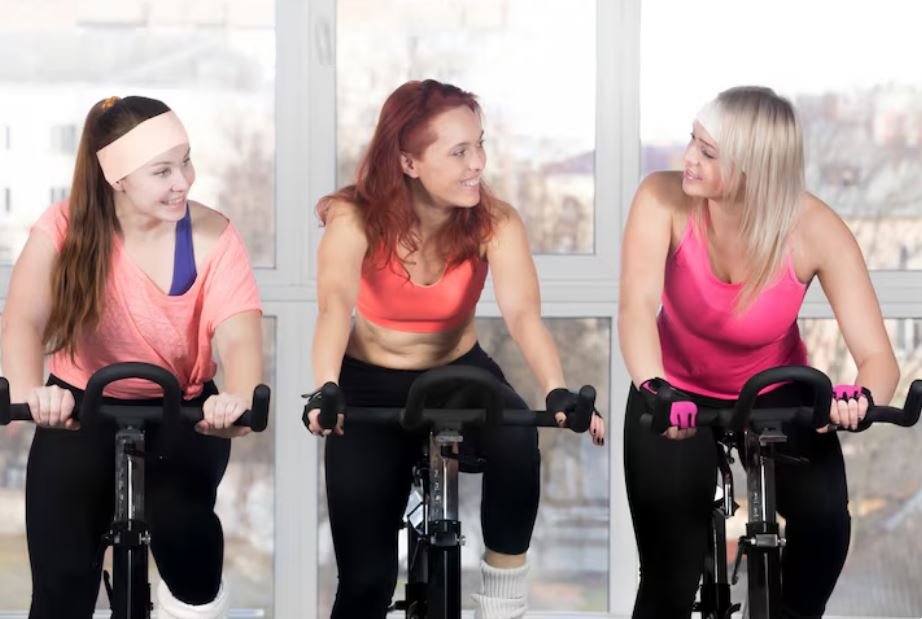
Sweaty, sociable, and rhythmic, spin classes were the lifeblood of boutique fitness for years. In pursuit of endorphins and a sense of solidarity, women from various cities pushed pedals in time with the music and flashing lights. That rhythm is slowly shifting now. With a remarkably similar motivation, more women are getting off the bike and lifting weights in order to feel strong rather than just slender.
This change is especially intriguing since it represents a more profound shift in the way women view health. The advantages of strength training for female physiology have been made abundantly evident by scientists such as Dr. Stacy Sims in recent years. She points out that long after the workout is over, resistance training is incredibly beneficial for increasing metabolism, balancing hormones, and increasing bone density. Strength training develops resilience that lasts, in contrast to spin classes that burn calories momentarily.
| Focus Area | Description |
|---|---|
| Trend | Women are increasingly moving from spin and cardio-based group classes toward strength and resistance training. |
| Core Drivers | Desire for stronger physiques, improved confidence, better bone health, and sustainable results. |
| Leading Voices | Fitness scientists like Dr. Stacy Sims and Dr. Andrew Huberman promote resistance workouts for women’s hormonal balance and longevity. |
| Celebrity Advocates | Jennifer Aniston, Brie Larson, and Meghan Markle champion strength routines for endurance, tone, and vitality. |
| Cultural Impact | The focus is shifting from “thinness” to “strength,” symbolizing empowerment and modern health ideals. |
| Reference | Paseo Club Blog – “Why Women Are Turning to Strength Training” |
For many women, switching from cardio to weight training is about redefining community rather than giving up on it. Instead of women racing toward a fictitious finish line, strength studios have evolved into safe, supportive spaces where they support one another through challenging sets. Plates lifted and confidence gained are more important indicators of progress in these settings than calories burned. It’s a profoundly sustainable change that feels noticeably more personal.
In order to safeguard her joints and vitality, Jennifer Aniston has discussed substituting balanced strength training sessions for strenuous cardio. Women’s strength can be both powerful and elegant, as demonstrated by Brie Larson’s documented superhero training journey, which included videos of her deadlifting and squatting with remarkable focus. Innumerable women who are looking for a more comprehensive approach to fitness have also been influenced by Meghan Markle’s preference for bodyweight exercises and resistance bands. These cultural moments demonstrate that lifting weights is a modern activity rather than a sign of masculinity.
The psychological advantages are equally strong. Women who engage in strength training experience a sense of grounded empowerment. While it might not be the answer to every issue, lifting a barbell does make many difficulties feel less difficult. Every repetition serves as a confirmation that your body is strong, capable, and versatile. Many people find the process especially healing; an hour dedicated solely to breathing, movement, and form becomes a unique haven away from everyday expectations and digital noise.
The benefits on a physiological level are numerous. Strength training increases lean muscle mass, which enhances long-term mobility, joint stability, and posture. The body burns calories more effectively even when at rest because it raises resting metabolism. Additionally, it’s especially helpful for women who are getting close to menopause, when their muscle mass naturally decreases. Women can considerably slow down that deterioration and preserve bone density by incorporating resistance training, which is an investment in their present and future well-being.
The way strength classes are changing to combine group energy with personal development is especially creative. Small groups of women train together in studios like New York’s StrengthHaus or Los Angeles’ LIFT Society, which are supervised by professionals. Accountability is established by the structure without using coercion. Every participant gains form, gradually ups the ante, and joins in on milestone celebrations. Women in their 50s are frequently seen deadlifting alongside women in their 20s as they each discover their own unique rhythm of empowerment.
This change has been sped up by social media. Previously dominated by cardio challenges and calorie counters, platforms now feature videos of women doing pull-ups, presses, and squats. The story is now about “getting stronger” rather than “getting smaller.” Regaining health on one’s own terms is the trend, not striving for perfection. In fitness culture, strength training videos frequently feature moments of authenticity, such as laughter, failure, and minor victories.
It’s interesting to note that this change enhances the function of spin classes rather than completely rejecting them. Though they now use it strategically as part of a hybrid program that also includes resistance days, many women still enjoy riding bikes. By concurrently increasing muscular strength and endurance, the combination promotes balance rather than burnout. Teachers are reacting as well: boutique gyms are starting to provide classes that combine lifting intervals with cardio bursts, demonstrating a more all-encompassing approach to wellness.
It is impossible to overstate this trend’s emotional component. Women are realizing that, unlike other forms of exercise, lifting weights fosters self-confidence. You encounter real resistance when you lift a barbell; it’s a sincere test that rewards perseverance and hard work. This way of thinking gradually permeates daily life, impacting how women manage relationships, stress, and obstacles in their careers. It’s the metaphor of fitness for self-belief.
The broader cultural message is unmistakable: beauty is strength. It’s about accepting one’s abilities rather than striving for an ideal of beauty. More women of all ages and body shapes are joining weight rooms, according to trainers, shattering the myth that fitness was limited to specific standards. The inclusive and upbeat movement, which embraces everyone from teen athletes to retirees, demonstrates that it’s never too late to begin strengthening.
The fitness industry is also changing as a result of this redefinition. Functional training zones are being given precedence over rows of cardio equipment in gym layout redesigns. Recognizing that their customers’ priorities have significantly changed, companies such as Peloton and Equinox now provide guided strength training programs in addition to cycling. An incredibly positive indication of maturity in fitness discourse is the fact that even wellness influencers who previously focused their content on diet or detox are now promoting progressive overload and balanced nutrition.
